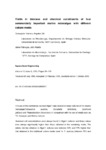Mostrar o rexistro simple do ítem
Yields in biomass and chemical constituents of four commercially important marine microalgae with different culture media
| dc.contributor.author | Herrero, Concepción | |
| dc.contributor.author | Cid, Ángeles | |
| dc.contributor.author | Fábregas, Jaime | |
| dc.contributor.author | Abalde, Julio | |
| dc.date.accessioned | 2015-01-21T16:31:50Z | |
| dc.date.available | 2015-01-21T16:31:50Z | |
| dc.date.issued | 1991 | |
| dc.identifier.citation | Herrero C, Cid A, Fabregas J, Abalde J. Yields in biomass and chemical constituents of four commercially important marine microalgae with different culture media. Aquacult Eng. 1991;10(2):99-110. | es_ES |
| dc.identifier.uri | http://hdl.handle.net/2183/13941 | |
| dc.description.abstract | The use of the commercial nutrient Algal-1 was studied in mass cultures of the marine microalgaeTetraselmis suecica, Dunaliella tertiolecta, Isochrysis galbana and Phaeodactylum tricornutum, in comparison with the use of media such as ES-Provasoli, and Walne medium. Maximum cell concentrations were always found in Algal-1 cultures and these values were always significantly higher than those obtained in the remaining media. The cellular density obtained in Algal-1 cultures was between 59% and 79% higher than that obtained in the traditional culture media used for T. suecica, between 70% and 109% for D. tertiolecta, between 33% and 60% for I. galbana and between 63% and 105% for P. tricornutum. The culture medium used affected the chemical composition of microalgal cells. Protein is the major cellular component for all the sepcies assayed and with all the media proved. Maximum values of protein/cell were obtained in Algal-1 cultures, except for P. tricornutum, whereas maximum values of reserve products (carbohydrates and lipids) never occurred in Algal-1 cultures, except for T. suecica. Differences in the protein content were higher than those found in the other cellular constituents. Maximum values of protein, lipids and carbohydrates per liter of culture always occurred in Algal-1 cultures, with significant differences in the values obtained in the remaining cultures. Maximum protein concentration (mg/liter) obtained in Algal-1 cultures was between 155% and 334% higher than that obtained in the remaining media for T. suecica, between 75% and 194% for D. tertiolecta, between 75% and 195% for I. galbana and between 93% and 225% for P. tricornutum. Daily protein yields (mg liter/day) also occurred in Algal-1 cultures. Ratios between protein values per liter of culture reached in each traditional medium and those reached in Algal-1 show values between 0•2 and 0•6 for protein content; therefore, Algal-1 cultures produced between 2 and 5 times more protein than the remaining cultures. Ratios for carbohydrates and lipids were between 0•4 and 1•0, and differences between traditional culture media and Algal-1 were generally lower than those obtained for proteins. Results showed better yields in Algal-1 cultures than those obtained with these traditional culture media. | es_ES |
| dc.language.iso | eng | es_ES |
| dc.publisher | Elsevier | es_ES |
| dc.relation.uri | http://dx.doi.org/10.1016/0144-8609(91)90003-3 | es_ES |
| dc.subject | Phaeodactylum tricornutum | es_ES |
| dc.subject | Tetraselmis suecica | es_ES |
| dc.subject | Biomass production | es_ES |
| dc.subject | Biosynthesis | es_ES |
| dc.subject | Algae Culture | es_ES |
| dc.subject | Marine microalgae | es_ES |
| dc.subject | Dunaliella tertiolecta | es_ES |
| dc.subject | Isochrysis galbana | es_ES |
| dc.title | Yields in biomass and chemical constituents of four commercially important marine microalgae with different culture media | es_ES |
| dc.type | info:eu-repo/semantics/article | es_ES |
| dc.rights.access | info:eu-repo/semantics/openAccess | es_ES |






